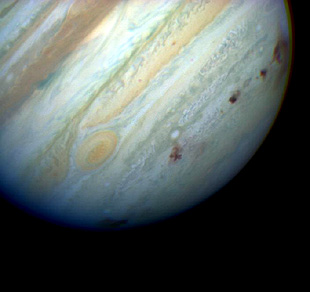遥感教程第19-23页¶
Imagine you are a famed planetary geologist who played the key role in bringing the study of impact craters into the mainstream of astrogeological science. You are among the few who truly believed in the catastrophic dangers of inevitable major collisions between the Earth and large enough asteroids and comets. Your experiences in studying nuclear explosion craters and the much bigger impact craters had you firmly convinced that disasters of that magnitude were genuine threats to mankind�s safety and even survival. So, in your later professional years you dedicated much of your time to a task shunned by all but a very few in the know: making an inventory of all detectable asteroids following potential Earth-crossing orbits. Then one night at the Observatory your wife, Carolyn, whom you had trained to help in this search, noticed a shift in a small bright object as she studied photographic plates exposed through the telescope on different nights. This surely was a comet. You contacted your colleague, David Levy, for confirmation - soon obtained. You let out the word to other observatories. Soon thereafter, one of these reported that the comet had split into pieces. Calculations then led to the astounding prediction that the pieces were on a collision course with Jupiter�s gravity field and would likely be drawn to it in a series of collisions. No one on Earth had ever witnessed such an event, on this planet or any other. You, the expert on impacts, would realize a life�s dream of actually observing and participating in a real time collision. Then, in July of 1994 it happened and the multiple collisions were of such magnitude as to be easily detected by the Hubble Space Telescope in space and many others on Earth. The world at last had come to know of the likelihood that big impacts are part of the Solar System�s past and future and that humans had better start thinking of ways to protect our planet.
这是基因鞋匠的传奇,可能是自太空时代开放以来最具影响力的行星地质学家。当然,这颗彗星通过被称为“鞋匠利维”使他的名字、他的妻子和他们的朋友的名字永垂不朽。在这一页上,我们将重述这一千载难逢的事件,它在发生时吸引了数百万人,并促使科学家甚至军方认真思考对地球生命造成的真正威胁影响。
Shoemaker Levy彗星¶
大约在同一时间,他们的同事和小行星搜索小组成员大卫·利维进行了类似的观察。在向其他天文台报告了他们的发现之后,有消息称,点的奇怪排列实际上是由于一系列单独的彗星体,每一个都有一个小的昏迷和尾巴,沿着与木星相连的轨道伸展了超过70万公里(43.5万英里)。然后,在1994年5月,有消息称这颗彗星,当时的名字是Shoemaker-Levy9(S-L9),正在碰撞过程中,将在当年7月连续撞击木星。这将是一个独特的事件——人类第一次见证重大的行星撞击!
科学家认为S-L9彗星起源于海王星之外。经过几个世纪的旅行,各种各样的天体扰乱了它朝向木星的轨道,因此它变成了一颗短周期彗星,其非常偏心的轨道使它非常接近木星。计算表明,S-L9之前曾经过离木星表面近20000公里(12428英里)的地方,在罗氏极限范围内(距行星中心的距离,在这个距离内,行星的引力很可能会破坏经过的天体),然后分裂成21个碎片。每个核的直径小于2公里(1.25英里)。HST拍摄了这张戏剧性的图片:
|哈勃广域行星照相机2,苏梅克-列维彗星的照片,1994年5月9日。|
天文学界迅速有效地动员起来参加这次活动。计算表明,1994年它很有可能撞上木星。随着对碰撞发生的时间和地点的更精确估计,科学家们意识到,高铁和伽利略至少可以观测到一些撞击,地球望远镜也应该能看到一些东西。猜测会发生什么从渗透到木星大气没有发生太多的大规模火球。观察者网络中的预期很高。
首先击中的是上图中绳子左端的小原子核。标记为A(后面的标记为B、C、D…贯通W [省略了I和O] 这颗行星撞击了木星南半球,产生了可检测到的闪光,随后西班牙和智利的天文台观测到了羽流。下面,我们展示了通过装有甲烷过滤器的望远镜拍摄的彩色红外图像序列(该望远镜吸收大部分波长的辐射,但在2.3微米左右的窄带中通过辐射):
左下表面的变化亮点是撞击的热闪光(其上方的另一个亮椭圆是大红斑,右侧可见IO)。在接下来的六天里,天文学家们直接或者在木星快速旋转的过程中,当撞击痕迹进入视线时,监测到了随后的大部分撞击。伽利略的照相机拍到了几个在夜间活动的肢体。接下来,我们展示了7月22日W的撞击,间隔7秒,显示了撞击期间和撞击后不久的闪光(它看起来像一颗脱离行星的卫星,但实际上是一个瞬间的反应,设置在阴影肢体内的黑暗表面上):
|记录W核对木星暗面影响的一系列远摄;看起来像一道明亮的闪光。|
其中一个最大的事件是7月18日G核的撞击。从这快速上升的羽流中,HST以时间序列成像,显示它在大约6分钟内达到3000公里(约1864英里)的高度:
|当G核冲入木星时,从木星表面升起的炽热的气体柱在黑暗面上升起,引发类似爆炸的反应;这里用hst s光学相机以不同波长(颜色)显示。|
HST通过一个绿色和基于甲烷的过滤器,成像了地表层中留下的疤痕(比地球直径大):
` <>`__19-76: How do you explain that the impact of the G fragment, probably only a few kilometers in size, which on Earth would make a crater several hundred kilometers wide, actually made a visible scar on Jupiter that was at least as big as the Earth's diameter itself? `ANSWER <Sect19_answers.html#19-76>`__
解释这一点以及其他的伤痕,我们可以看到,每一个原子核都会在木星外层大气中冲出一条隧道,使其气体受到震动、压缩和闪烁。来自彗星和大气层的物质进入半球状羽流,也以新月形云的形式(受撞击角的影响),与地球上与地面撞击有关的方式大致相同。形成疤痕的暗物质可能是来自木星大气的变色成分,如HCN或硫衍生物。与固体地面陨石坑不同,木星上的陨石坑逐渐消散,尽管它们的可见痕迹持续了几年。
在所有撞击发生后,下面三张木星的照片显示了这种持续性。首先是一个自然的颜色视图,由HST制作的一个侧面显示了撞击点。
第二张是从西班牙卡拉阿尔托天文台拍摄的彩色红外图像:
第三张图片是由HST的紫外线照相机拍摄的,它使疤痕H、Q、R、D、G和L(上半球的圆形物体是其中一个卫星的阴影)形成了鲜明的对比:
如果S-L9的任何碎片撞击地球,人类(当然是恐龙)以前从未经历过的巨大灾难将接踵而至。我们被警告了!
因此,结束这一探索太阳系的伟大旅程!前18节应该让你们相信,我们的地球是一个非常特别,但非常宜居的地方。但是,这一部分希望能让你看到这样一个事实,即太阳系的其他部分虽然不适宜居住,但其本身显然是令人着迷的。最近,天文学家在我们星系的其他地方发现了几个新的行星系统。谁知道我们自己之外还有什么不可思议的世界?也许有一天,我们会远程感知到一个姊妹行星,然后,当这项技术发展起来时,我们会通过探测器甚至我们的物种来访问它。
同时,在未来的太阳系探索中应该优先考虑什么。美国航天局、欧空局、俄国人和其他太空项目将做出这些决定。但是公众,特别是太空鉴赏家的意见,他们“买单”是非常需要的。作家(NMS)有他自己最喜欢的“榜首”:火星!我们现在已经足够认识到,如果这颗行星只是更大一些(从而容纳了更多的大气层),其潜在的生物发展能够适应它接收到的太阳能的减少,那么它很可能是生命发展的有利宿主。事实上,这种可能性还没有被排除。漫游者和轨道飞行器将有助于搜索。人的来访将是决定性的。
现在是时候将我们的遥感视野扩展到无穷大,来展示这项技术是如何成为整个宇宙探索的核心。下一节,20,可能是最具煽动性的。
(*) With deep sorrow, the writer (NMS) must report here the death of a good friend and teacher of impact principles, Eugene M. Shoemaker, who may rightly be called "the father of Astrogeology." He was killed on July 18, 1997 (three years to the day after the main SL-9 event), in an auto collision (impact, ironically) in the interior of Australia, while pursuing meteor craters that are so well displayed on that continent. It is fitting that part of Gene's ashes were onboard Lunar Prospector so that when that probe finally descended and crashed onto the lunar surface in search of water, in a sense he too "landed" on the Moon–a long time goal of his (to be a lunar astronaut) that health problems thwarted just prior to the Apollo program. A second honor was posthumously awarded him by renaming the NEAR probe to the asteroid 433Eros as the NEAR-Shoemaker spacecraft. And, to memorialize him on Earth, the meteoritical community, including the Australian contingent, has renamed the 30 km (18 mile) wide Teague crater to the Shoemaker crater, as seen below:
